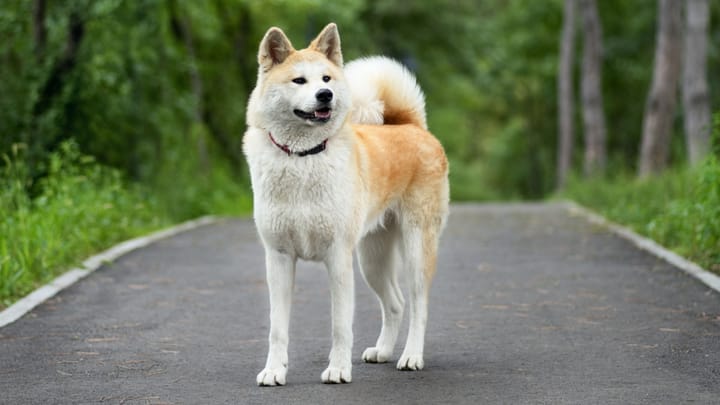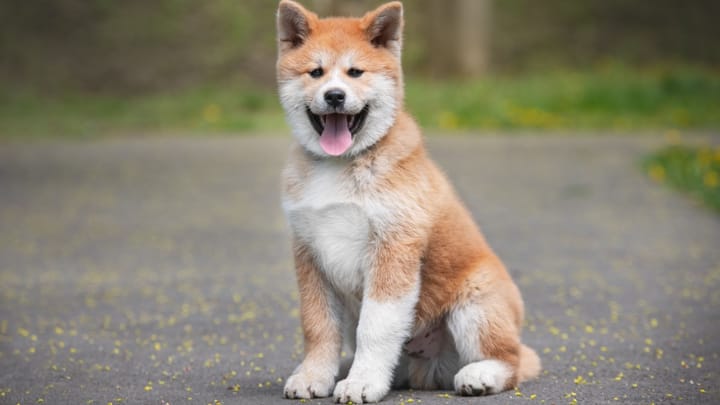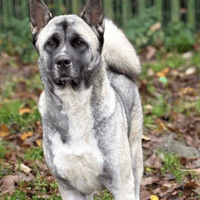Akita Inu


The Akita Inu is a dog originating from Japan. Large in size, it is robust and well-proportioned. Very calm in nature, the Akita is sensitive and affectionate towards members of its social group, but is very wary of strangers. An Akita can adapt to a number of different lifestyles, being happy to sleep all day or equally to accompany its master in a variety of activities. Being stubborn and not very sociable with other dogs, only experienced owners who are aware of this dog’s characteristics should consider getting one.
|
Life expectancy |
The Akita Inu has a life expectancy of between 11 and 15 years |
|
Temperament |
|
|
Size |
Large
|
|
Adult size |
Female
Between 23 and 25 in
Male
Between 25 and 28 in
|
|
Adult weight |
Female
Between 62 and 75 lb
Male
Between 71 and 88 lb
|
|
Coat colour
Any colour is accepted except merle. Fawn, sesame, pinto, brindle and white are all accepted coat colours for this breed. All the colours, except for white, should be "urajiro", which defines the presence of white-ish hair on the sides of the muzzle and cheeks, under the jaw, on the neck, on the chest, on the stomach, as well as on the lower part of the tail and on the inside of the limbs. |
White Red |
|
Type of coat
The coat is short to mid-length. This dog has a double coat: its outer coat is hard and straight, while the undercoat is soft and dense. The coat is slightly longer at the withers, buttocks and tail. |
Short |
|
Eye colour
The Akita Inu has brown eyes; the darker they are, the closer they are to the breed’s official standards. |
Brown
|
|
Purchase price |
The Akita Inu costs between £530 and £920 |
We’re sure you’ve heard of Hachiko, the most famous Akita Inu in the world: it all started in the 1920s in Tokyo, where Hachi would accompany his master to the Shibuya railroad station everyday, and faithfully wait all day, in the same spot, for his return.
After 5 years of this, his master sadly died at work and thus never returned. But the story doesn’t end there: the most extraordinary part is that Hachi continued to wait for his master, over the course of 10 long years. In 1935, Hachiko passed away and a bronze statue was erected in his memory, in front of the train station where he had waited for his owner to return for so many years.
More details about the Akita Inu
Akita Inu: Origins and history
The Akita Inu is an ancient dog, originally from the mountainous regions of the Akita prefecture in Japan. First a hunter of wild boar, this breed then became a fighting and guard dog. Nowadays in Japan, it is considered a ‘national treasure’, part of the list of Japanese traditions to defend and preserve. There were two bloodlines originally: Dewa and Ichinoseki. The first, which showed clear Molossoid and cross-breeding signs, was bred in America to create the “American Akita”; the second, which resembled the original breed much more closely, was chosen by the Japanese as the ideal variety and is now the Akita Inu that we all know today.
Physical characteristics of the Akita Inu
The Akita Inu is a large Asian Spitz with a strong, well-proportioned and robust build. It has a large forehead and pronounced stop. The eyes are relatively small, almost triangular in shape, just like the thick, slightly rounded ears that bend forward to align with the tilt of the neck. The tail stands tall and large, curling round to touch the back. This dog emits the image of great nobility and dignity, combined with an air of simplicity.
FCI classification of the Akita Inu
-
Group 5 - Spitz and primitive types
-
Section 5 : Asian Spitz and related breeds
Akita Inu: Characteristics
Akita Inu: Behaviour
Training a Akita Inu
Don’t trust blindly in its appearance; the Akita’s placid personality can sometimes hide its fiery and stubborn side. Akitas quickly understand and assimilate what is being asked of them, but can come up with strategies to avoid obedience if they perceive the commands as incoherent or unfair.
Neither playful or particularly greedy, a good relationship is most likely what will encourage this dog to cooperate with its master. If there’s a lack of trust, then the training will suffer.
Training should be soft and gentle so as to not perturb this sensitive dog, but should equally be firm to keep the animal in check. The Akita puppy should start training from a very young age to avoid picking up bad habits.
You will need to keep engaging the Akita puppy with its training during the first few months of its life, despite the many distractions that will undoubtedly be much more interesting to a puppy than training sessions.
Akita Inu: Lifestyle
Breed compatibility Akita Inu
Akita Inu: Purchase price
The price of an Akita Inu varies depending on its origins, age and sex. You should budget around £920 for a dog registered with the KC.
As for your monthly budget, you should set aside around £40 to £60 to cover all of its grooming and nutrition needs.
Akita Inu: Shedding
Heavy !
The Akita Inu moults an impressive amount during the annual shedding periods - it loses fur in tufts. It will therefore need long, and sometimes tedious, brushes on a daily basis during these times of the year.
Akita Inu: Grooming
Like a cat, the Akita Inu takes care of most of its grooming needs by itself - this dog is very clean. Maintaining its appearance and hygiene is therefore not difficult, but should still be tended to frequently.
The eyes and ears should be monitored and cleaned on a regular basis.
Akita Inu: Health
The lifespan is around 13 years.
The Akita’s primitive nature could translate into robustness, but in reality, it remains fragile in a number of ways.
This dog can deal with the heat, but will always prefer a cool space to relax in.
The Akita Inu’s thick coat protects it well from the cold and humidity. This breed can be quite content outdoors, whatever the weather.
Food is not this dog’s weakness, so the Akita is not predisposed to obesity. Just make sure you’re not overfeeding your dog, especially if it isn’t too active.
- Sebaceous adenitis (hereditary skin disease)
- Vogt-Koyanagi-Harada syndrome, or VKH (hereditary disease: inflammation of the brain or iris, depigmentation of the skin and nose, etc.)
- Progressive retinal atrophy
- Von Willebrand Disease (hereditary bleeding disorder)
Do you want a Akita Inu dog ?
Frequently asked questions
What is the difference between an American Akita and an Akita Inu?
There is a clear physical difference between the two types of Akitas. The American Akita is much larger and heftier than the Japanese Akita (or Akita Inu). The American Akita has looser skin, particularly noticable in the face. Its eyes are larger and more almond-shaped than the small eyes of the Japanese Akita. American Akitas also come in a much larger variety of coat colours - every colour is acceptable. In terms of character, the breeds are quite similar, though the Akita Inu tends to be more independent and stand-offish than the confident American Akita.
Learn more about the American Akita!
Is the Akita Inu dangerous?
Akita Inus are territorial and extremely protective of their "pack". That, coupled with the fact that they are large and powerful, gives them a reputation for being dangerous. Akitas do need a lot of socialisation and proper training from an early age. However, for an experienced and responsible handler, these dogs can become wonderful companions for the whole family.
Find out how to socialise your puppy!
Is the Akita Inu a good family dog?
Akitas are generally not recommended for families with young children, due to their sometimes dominant and aloof character, which requires expert handling to avoid it leading to agression. However, if they are raised with children, Akita Inus will consider them as members of their "pack", and bond very closely with them as a result. The main thing to consider is whether or not you are prepared to put in the time and effort it will take to properly train and socialise this beautiful breed.
Discover more incredible Japanese breeds!







